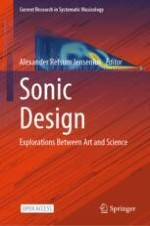Open Access 2024 | Open Access | Buch

Sonic Design
Explorations Between Art and Science
herausgegeben von: Alexander Refsum Jensenius
Verlag: Springer Nature Switzerland
Buchreihe : Current Research in Systematic Musicology
Open Access 2024 | Open Access | Buch

herausgegeben von: Alexander Refsum Jensenius
Verlag: Springer Nature Switzerland
Buchreihe : Current Research in Systematic Musicology
This open access book offers a historical context and an overview of the field's current artistic and scientific research. Sonic design includes the construction and performance of acoustic instruments but also recording, editing, mixing, and synthesizing sounds using analog and digital electronic devices. This book explores sonic design from the perspectives of music theory, music perception, embodied cognition, phenomenology, soundscape studies, acoustics, new interfaces for musical expression, sound and music computing, and music information retrieval. The chapters are selected contributions from an international seminar organized to celebrate the achievements of Professor Rolf Inge Godøy at the University of Oslo. As a composer, researcher, teacher, and supervisor, Professor Godøy has been central in developing a holistic approach to sonic design, from theory to practice. This book offers a comprehensive overview of the field's current state, making it essential reading for students, practitioners, and researchers across a wide range of disciplines.